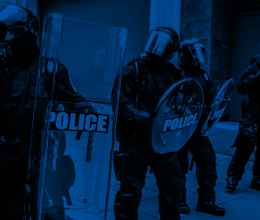Photo by Raymond Wambsgans through Flickr Creative Commons.
Last month, President Obama took a preliminary step to curb decades of militarized policing in America.
The call for change, however, began a year ago.
Raising the Alarm
The ACLU issued “War Comes Home: The Excessive Militarization of American Policing” in June 2014. The report outlined how billions of dollars of military equipment flows from the federal government to state and local police departments. It also detailed how militarized policing disproportionately impacts communities of color that have become casualties of this home-grown war on drugs.
Soon after the report’s release, Michael Brown was killed in Ferguson, Missouri, and community unrest over the shooting death of the unarmed teen was met with a show of force by local police armed with military-grade equipment, including body armor, gas masks, shotguns, automatic rifles, tear gas launchers, and mine-resistant ambush protected vehicles.
Through computer screens, cells phones, and television sets the world saw what communities of color in America see too much of—extremely aggressive tactics and weapons that far outweighed the perceived threat.
Read "War Comes Home: The Excessive Militarization of American Policing" and our blog, "Community Safety: A Call for a Moratorium on 1033."
Several organizations, including the ACLU, called for a moratorium on the Defense Department’s 1033 Program that arms local law enforcement with military weapons and gear.
President Barack Obama formed a task force, and called for an investigation of the 1033 and similar programs.
In April, the ACLU sent a letter to Congress calling on them to enact reforms.
Just a Beginning
A month later, the president announced via executive order that the federal government would no longer be permitted to supply police departments with certain types of military weapons and vehicles. Banned items include: bayonets; armored vehicles; grenade launchers; some camouflage uniforms; and ammunition of .50-caliber or higher. The order also established a “controlled equipment” list, with tightened requirements before federal agencies can transfer equipment to local cops. These include riot control equipment and drones. Federal agencies also will require local police to provide more data so the government can better track equipment.
While the ACLU has long called for these reforms, we still need Congress to make these changes permanent. Unless it does, a new administration could remove the restrictions and ramp up the 1033 program again.
Before you dismiss this as a distant issue that does not impact Ohioans, take a minute to see how Cincinnati’s SWAT deployment is concentrated in communities of color. Find out how SWAT officers killed Tarika Wilson of Lima, Ohio, as she held her infant son.
Another Ferguson is not so far away.








